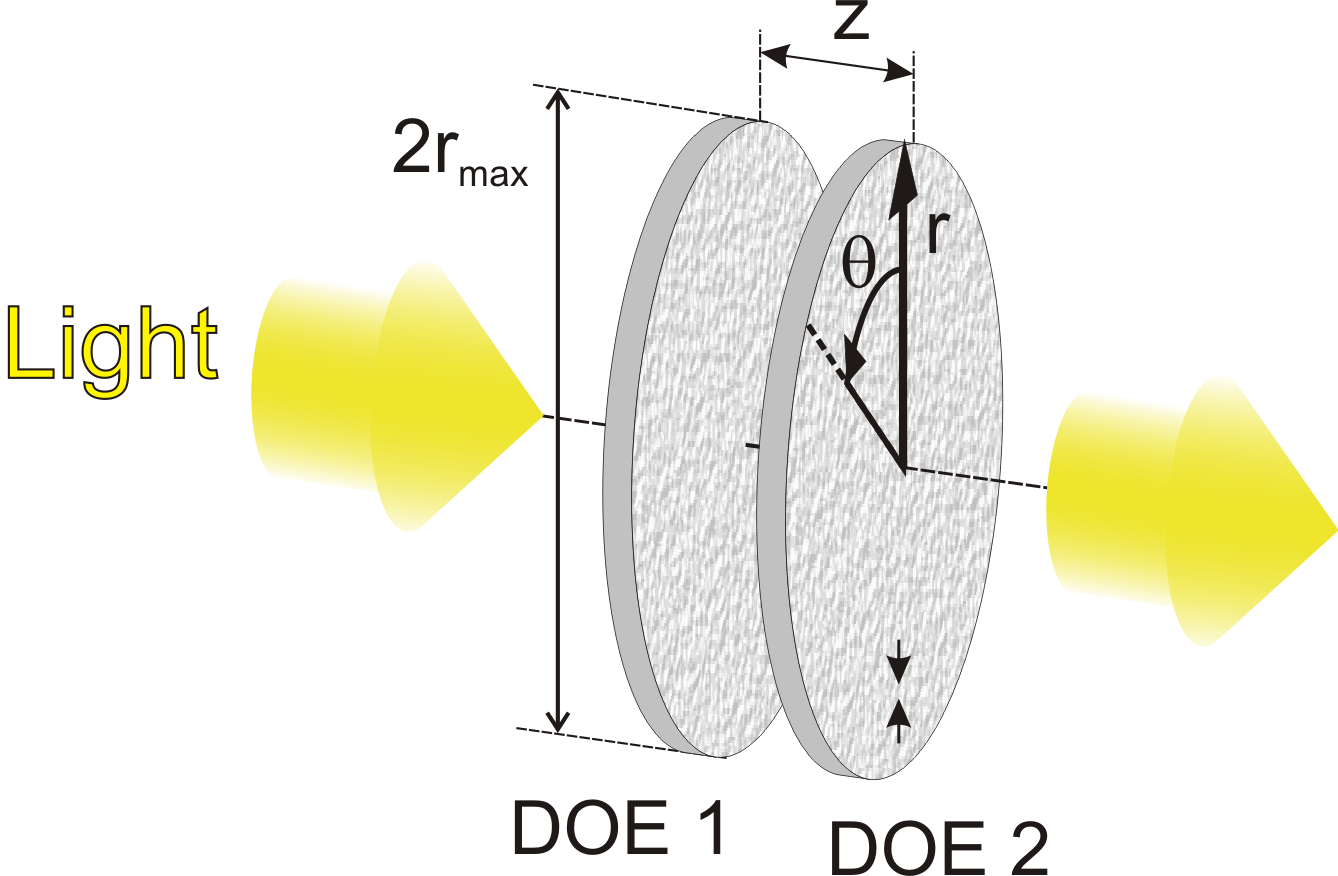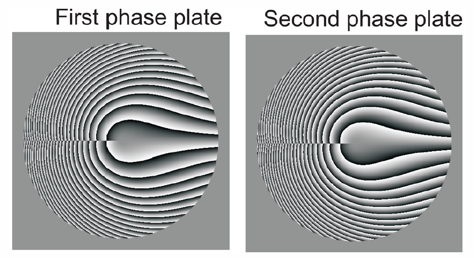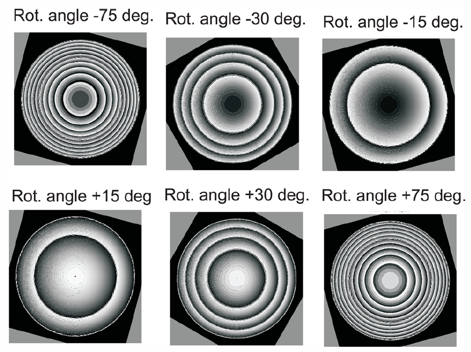More Details on Moiré Diffractive Optical Elements
The working principle of a Moiré Diffractive Optical Element (MDOE) is illustrated in Fig.1.
 |
|
Fig. 1: : Basic principle (drawings not to scale): Two specially designed diffractive optical elements (DOEs) are placed very closely behind each other. A rotation of one element around the central axis leads to a Moiré pattern which determines the overall optical performance of the joint DOE. |
The MDOE consists of optically transparent, flat plates made of glass, plastic etc. with an a specially designed imprinted phase profile. The DOEs can be produced such that the combined optical element has an almost 100 % efficiency, i.e. there is no absorption or diffraction into undesired diffraction orders.
Besides numerous other applications one of the most interesting features is probably that such a set of diffractive elements can act as a varifocal Fresnel lens, with a focus that can be changed in a very wide range just by rotating the two elements with respect to each other. As an example, a MDOE with a typical pixel size of 1 µm and a diameter of 5 mm would have a refractive power adjustable in a range between -50 to +50 diopters corresponding to a focal length range between ±2 cm and ±∞. It is possible to introduce an offset focal length around which the focal length can be varied.
Such a lens can be used in the same way as a “normal” glass lens, for example for imaging (cameras, telescopes, microscopes), or for beam projection purposes (as, e.g. in beamers, overhead projectors, laser scanners), but with the additional advantage that its focal length is variable. In imaging applications, this allows to construct systems that act like a human eye, i.e. they can focus by variation of the lens refractive power, instead of using bulky “zoom-optics” that works by axial shifting the lens positions.
An example for a pair of DOEs that act as a varifocal Fresnel lens is sketched in Fig.2.
 |
|
Fig.2 Two DOEs designed to form a MDOE acting as a Fresnel lens with a refractive power that depends on the mutual rotation angle. Grey-values correspond to phase shift values between 0 and 2π. Note that the two DOEs are actually identical if one of them is flipped around its horizontal axis. |
If the two Does of Fig.2 are placed directly behind each other, then the focal length of the Fresnel lens that is formed by the joint DOE pair depends on their mutual rotation angle. An example for the Fresnel lenses that are produced due to different rotation angles is plotted in Fig.3.
Overlapped rotated phase plates |
|
Fig.3 Result of the superposition of the two DOEs of Fig.2 at different mutual rotation angles of (upper row:) -75, -30, -15, and (lower row:) +15, +30, +70 degrees. |
Numerical calculations show that a mutual rotation of the two DOEs by an angle between -90 degrees and +90 degrees is possible, with only a low loss of 15% in the efficiency of the combined Fresnel lens.
If one of the two DOEs is continuously rotated with constant speed with respect to the other, the corresponding Fresnel lens is periodically scanning in an adjustable range of focal lengths. This may have applications in imaging systems (inspection cameras) and beam scanning systems (bar-code readers etc.). For example, a periodically rotating DOE lens which is combined with an imaging system that uses a shutter that is phase locked to the DOE rotation (i.e. the shutter opens always at a certain angular position of the DOE) sharply focuses at objects in a certain distance that depends on the relative phase between the shutter openings and the DOE rotation. If the shutter acts electronically (e.g. a gateable image intensifier) focusing can be controlled purely by electronic means, by just varying the phase between DOE rotation and shutter openings. Numerical calculations also show that a mutual rotation of the two DOEs by an angle between -90 degrees and +90 degrees is possible, with only a low loss of 15% in the efficiency of the combined Fresnel lens.
The principle can be straightforwardly generalized to produce other interesting MDOE elements with properties that are continuously adjustable by a mutual rotation. This comprises axicons with a variable refractive power (interesting as beam couplers in fiber optics), continuous phase shifters (interesting for applications in interferometers or frequency sideband generation), or spiral phase plates with a variable helical index (used e.g. in optical tweezers to produce doughnut beams, or in new phase contrast methods in optical microscopy).




